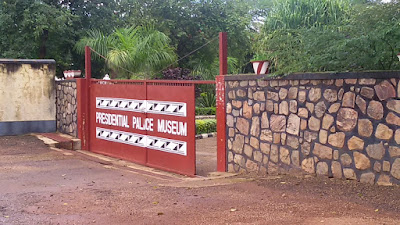On August 10, GYC participants visited Habyarimana’s
Palace where, we were given a tour of the house and the site of the plane
crash.
 |
| At the gate of the presidential palace museum. |
As we walked in we visited the first house of the president before his
palace was built. The house was very old but in the sitting room stood a statue
of a man playing the traditional guitar which was actually a gift from Ghana.
We were given the chance to then walk around the house looking through each
room. As we left the house we walked the path to where the plane of Habyarimana
crashed.
Along the way the tour guide pointed out to us that next to the where
the pool stood was where Habyarimana kept his python. The python was a gift
from the former president Mobutu to Habyarimana. It is believed that the python
was linked to Habyarimana through a witch doctor. When the plane crashed
killing Habyarimana the python disappeared. No one around the palace is sure of
what happened to it.
 |
| the pool for his python. |
As we finally got to the plane crash site, scattered
through the yard was the many pieces of the plane from a propeller to a wing.
When the plane had initially crashed it was not a part of the palace. The
museum actually had to buy the land after to preserve the plane crash because
people were taking parts from it. The
plane was shot on April 6, 1994 killing three crew members and nine people including
the president of Burundi, Ntaryamira. The plane crash is noted as the start of
the 1994 genocide. The news went out quickly, where the family of Habyarimana
was evacuated. The family consisted of eight children, three girls and five
boys and the president’s wife, Kanziga. It is later known that they fled to
France where his children had French nationalities and his wife was granted
asylum.
 |
| The plane crash outside of the museum. |
As we moved out of the crash site and into the house he had built we learned more about the genocide.
 |
| The house. |
In the large living room there were many photos and information. The first photos showed the training of the army and the types of methods and weapons that were used in the killing of over thousands of Tutsi. The next set of photos depicted the after effects of the genocide leaving behind many refugees and orphans. The last set of photos showed the reconciliation process as the GACACA courts. We were then given a full tour of the house.
The house has over 20 rooms ranging from the master bedroom, to the children’s room and even a church. The most interesting of these rooms was the secret room that was built in case the family was attacked. The strategy of the house first started from the stairs leading to the family’s room. As you walked along the step it would make a sound indicating how close someone was to the top of the stairs. The tour guide told us that Habyarimana was always the last one to go up the stairs so that if anyone else came after he would know that the house was under attack. He could listen to the different sounds each step made and as a person came closer he could gather the family and move to the secret room. The entrance to the room was located in the children’s television room. Along the wall was built a shelf where the kids could keep their toys but also along the shelf was a door that held guns and ammunition. Habyarimana and his wife were the only ones with the key to this door. On the other side of the shelf stood the door to the secret room. As you enter there are two flights of steps that lead to a flat that could be used as a resistance zone. The room was built that if someone else tried to come up the steps it was easy for Habyarimana to see who was coming but to also shot at them.
 |
| The room of the president. |
Aucun commentaire:
Enregistrer un commentaire